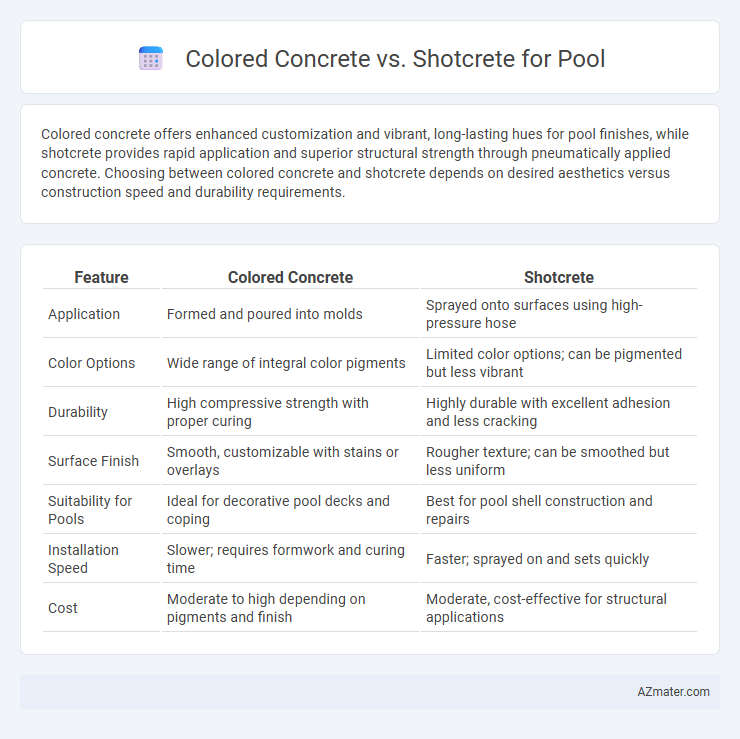Colored concrete offers enhanced customization and vibrant, long-lasting hues for pool finishes, while shotcrete provides rapid application and superior structural strength through pneumatically applied concrete. Choosing between colored concrete and shotcrete depends on desired aesthetics versus construction speed and durability requirements.
Table of Comparison
| Feature | Colored Concrete | Shotcrete |
|---|---|---|
| Application | Formed and poured into molds | Sprayed onto surfaces using high-pressure hose |
| Color Options | Wide range of integral color pigments | Limited color options; can be pigmented but less vibrant |
| Durability | High compressive strength with proper curing | Highly durable with excellent adhesion and less cracking |
| Surface Finish | Smooth, customizable with stains or overlays | Rougher texture; can be smoothed but less uniform |
| Suitability for Pools | Ideal for decorative pool decks and coping | Best for pool shell construction and repairs |
| Installation Speed | Slower; requires formwork and curing time | Faster; sprayed on and sets quickly |
| Cost | Moderate to high depending on pigments and finish | Moderate, cost-effective for structural applications |
Introduction to Colored Concrete and Shotcrete
Colored concrete offers vibrant, customizable finishes for pools by integrating pigments directly into the concrete mix, enhancing both aesthetics and durability with long-lasting color consistency. Shotcrete, a wet or dry concrete application method sprayed onto surfaces, provides superior structural strength and versatility in complex pool shapes and contours. Combining colored concrete with shotcrete allows for visually appealing, resilient pool designs that resist cracking and environmental wear.
Key Differences Between Colored Concrete and Shotcrete
Colored concrete for pools involves mixing pigments directly into the concrete to achieve a uniform hue, offering enhanced aesthetic control and durability. Shotcrete, a spray-applied concrete, allows for faster application and flexible shaping, especially on complex pool designs, but may require surface treatment for color consistency. Key differences include application methods, color integration--integral versus surface-applied--and texture control, which affect longevity and visual uniformity in pool construction.
Durability and Longevity Comparison
Colored concrete offers enhanced durability with its integrated pigments that resist fading and surface wear, making it ideal for pool decks exposed to sunlight and chemicals. Shotcrete, known for its dense, high-strength application process, provides superior structural integrity and longevity, especially in complex pool shapes and repairs. Both materials exhibit excellent resistance to cracking and environmental factors, but shotcrete typically outperforms in long-term durability due to its compacted, reinforced matrix.
Installation Processes and Techniques
Colored concrete for pools involves traditional pouring and forming techniques allowing precise color integration through pigments mixed in the concrete, ensuring uniformity and customization across surfaces. Shotcrete is applied using high-pressure spraying methods, ideal for complex shapes and rapid installation, providing a dense, durable layer that can also be pigmented for aesthetic appeal. Installation of colored concrete requires formwork and curing time, whereas shotcrete demands skilled nozzle control and immediate surface finishing to achieve optimal adhesion and texture.
Cost Analysis: Which Is More Budget-Friendly?
Colored concrete typically incurs lower initial costs compared to shotcrete due to simpler application methods and reduced labor requirements, averaging around $6 to $12 per square foot. Shotcrete, often priced between $8 to $15 per square foot, demands specialized equipment and skilled operators, increasing overall expenses. For pool construction projects prioritizing budget, colored concrete generally offers a more cost-effective solution without compromising durability and aesthetic appeal.
Design Flexibility and Aesthetic Options
Colored concrete offers extensive design flexibility with a wide range of pigmentation options, allowing for customized hues and patterns that enhance pool aesthetics. Shotcrete provides versatility in shaping complex curves and intricate features, enabling unique, sculptural pool designs that integrate seamlessly with landscaping. Both methods support diverse finishes, but colored concrete excels in consistent, uniform color applications, while shotcrete allows for textured and three-dimensional surface effects.
Maintenance Requirements and Lifespan
Colored concrete pools offer increased durability with a typical lifespan of 25 to 30 years when properly maintained, requiring routine cleaning and periodic sealing to prevent staining and surface wear. Shotcrete pools, known for their structural strength and flexibility in design, can last 30 to 50 years but demand regular maintenance such as surface smoothing and crack repairs to avoid water infiltration. Both materials require vigilant upkeep to maximize longevity, though shotcrete's dense application often results in fewer long-term maintenance issues compared to colored concrete.
Safety and Slip-Resistance Features
Colored concrete offers enhanced slip-resistance through textured finishes and integrated aggregate, providing a safer pool surface by reducing the risk of slips and falls. Shotcrete, applied as a high-pressure spray, creates a dense and durable surface that can also be customized with non-slip additives for improved traction. Both materials support safety, but colored concrete allows more design control to optimize slip-resistant features around pools.
Environmental Impact and Sustainability
Colored concrete for pools typically utilizes natural pigments and can incorporate recycled aggregates, reducing environmental impact by minimizing raw material extraction and waste. Shotcrete offers sustainability benefits through its efficient application process, requiring less formwork and producing less construction waste, while also enabling the use of supplementary cementitious materials like fly ash or slag to lower carbon emissions. Both materials support eco-friendly pool construction, with shotcrete often favored for its reduced water consumption and faster curing times, which contribute to overall energy savings.
Best Applications: Choosing the Right Material for Your Pool
Colored concrete offers vibrant, long-lasting aesthetics ideal for decorative pool decks, coping, and patios, enhancing outdoor spaces with customized hues and patterns. Shotcrete provides superior structural strength and flexibility, making it preferable for complex pool shapes and renovations requiring strong, fast-curing materials. Selecting colored concrete suits design-focused projects, while shotcrete is best for durable, high-performance pool shells and custom builds.

Infographic: Colored concrete vs Shotcrete for Pool
 azmater.com
azmater.com